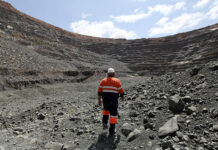
SOME 830 former illegal miners operating on Petra Diamonds’ lease area at Kimberley have been now been legalised as artisanal miners on ground given up by Petra.
One of the key conditions in the deal was the former illegals had to make commitments that they would stop interfering with Petra’s other extensive operations which recover diamonds from surface tailings dumps.
But the key outstanding issue is what will happen when the 600 hectares of ground they have been allocated is worked out and the newly-legalised artisanal miners start looking around for new areas to mine.
The deal was announced at last week’s Junior Indaba mining conference by deputy minister of mineral resources, Godfrey Oliphant, who said mining permits had been been issued to the former zama-zamas – as the illegal miners are named. Oliphant added some of them had been also been licenced to trade and deal in rough diamonds.
Petra Diamonds has not issued a statement about the deal. Asked for comment, Gert Klopper, communications manager at Petra’s operations, said: “We are constrained in terms of what we can say about this arrangement, but we have always been keen to find a way to legalise the operations of the zama-zamas.
“We give full credit to the authorities including the Department of Mineral Resources (DMR) and the Northern Cape Premier’s Office in setting this arrangement up.
“We believe this is a good deal which will add value to the nation, but nothing is for free and we have had to give up some 600ha of ground called ‘the floors’ to make it work. This ground is not critical to our operations,” he said.
The floors are areas where the early miners laid out the diamond-bearing kimberlite ore mined from underground to allow it to weather and break-up before treating the ore further to recover the diamonds. Layers of that ore containing diamonds still cover the floors.
The deal follows comments by Petra CEO, Johan Dippenaar, on April 23 that production from Petra’s Kimberley operations had been disrupted during the March quarter through the zama-zamas physically blocking access to high-grade dumps as well as affecting the haulage routes used to bring dump material to the treatment plant.
The Kimberley operations have been plagued by the activities of the zama-zamas for nearly two years despite the efforts of Petra – and former mine owners De Beers – to get the South African Police Services and the DMR to take action against the illegal miners.
Klopper said some 830 former illegal miners had formed themselves into two co-operatives and moved off Petra’s lease area on to the floors. He said there were still some “10 to 20” illegals on Petra’s ground who had refused to join the co-operatives.
Klopper added this situation was “manageable” and the remaining illegals seemed to be motivated mainly by political considerations. “It’s a bit of sensitive issue,” he replied when asked what Petra intended doing to get rid of them.
Asked what Petra management thought would happen when the newly-legalised artisanals worked out the ground allocated to them Klopper replied: “Mining is a finite business.
“It is up to the relevant authorities, led by the DMR and the Northern Cape Premier’s office, to either make it clear up-front to the artisanals that the ground they now own has a limited life, or to find new ground for them to sustain their operations in the future once the floors are mined out.”










